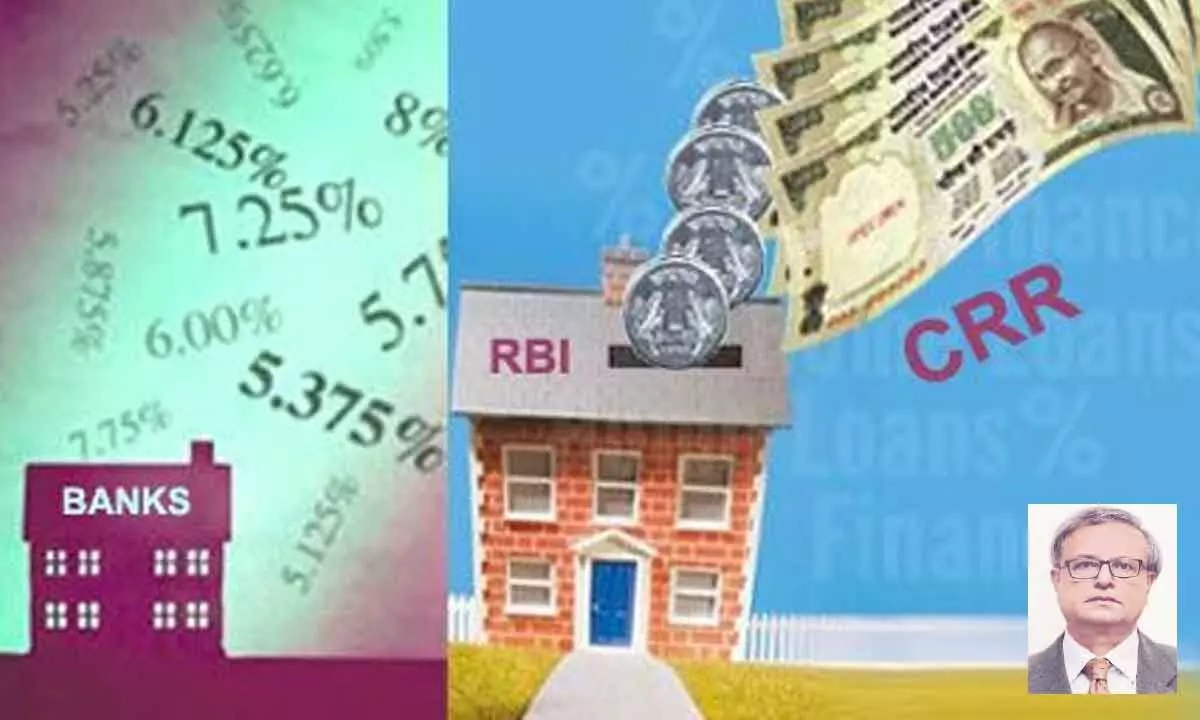No end in sight to the debate over CRR pros and cons
Beyond MPC’s purview, only RBI can change CRR through executive action
image for illustrative purpose

Those opposed to CRR argue that many countries like Canada, the UK, Australia and Sweden, have abolished CRR and India should follow suit. Pitted against the detractors, are those who defend CRR, essentially on its use as a monetary policy instrument. Situations requiring a quick and effective response, such as that in August when there was huge build-up of more than Rs. 10 lakh crore of liquidity with banks, which could have aggravated inflation, finds an ideal tool in CRR
Last month’s imposition of Incremental Cash Reserve Ratio (ICRR) by the Reserve Bank of India (RBI) and its phased withdrawal announced a few days ago has revived the debate on continuance of CRR or otherwise.
As it is, CRR has had a chequered history in India. Introduced in 1935 as a measure to ensure safety and liquidity of bank deposits, it quickly became an instrument to regulate lending operations and to control money supply. It touched a high of 15% of Net Demand and Time liabilities (NDTL) of banks in 1989, when inflation was running high, and a low of three in 1962. It currently stands at 4.5% of NDTL.
As a monetary policy instrument, it is not changed often because it is seen to be a blunt tool, removing or injecting at one stroke, vast amounts of liquidity from/to the banking system. Even when changes are made, they are incremental and temporary, and rolled back when the situation normalizes, leaving the CRR unchanged.
It is significant that CRR is outside the purview of the Monetary Policy Committee (MPC) of RBI, and can be changed only through executive action of RBI. The MPC concerns itself with setting benchmark interest rates through Repo Rate, Reverse Repo etc.
The August decision on ICRR is thought to have taken out Rs one lakh crore of liquidity from the system and was made because of the huge build-up of excess liquidity caused by the withdrawal of Rs 2000 denomination notes and the HDFC merger. This is an example of the power of the instrument in containing liquidity.
CRR’s critics, however, question its very need. They say that one of its original objectives, to provide assurance to depositors about a bank’s ability to meet its immediate obligations, is now met through the ability of RBI to meet cash needs through the network of currency chests throughout the country, and deposits with RBI are not required. In any case, they opine that the other reserve ratio, the Statutory Liquidity Ratio (SLR) which banks are required to maintain, provides them with enough liquid assets to meet contingencies.
The other objective of CRR, namely, to impose a constraint on banks’ capacity to lend by requiring them to maintain a percentage of their deposits as cash with RBI, is being met through the Basle norms now in place, critics say, with its mandatory capital requirements and compliance with ratios such as Capital Risk Adjusted Ratio and Leverage Ratio. Unbridled expansion of bank loans is not possible with these prudential measures in place, according to the critics.
On its role as a tool for monetary control, its detractors say that there are other instruments in place like OMO and Repo rates to influence liquidity and tackle inflation, implying that CRR is not required for monetary control.
CRR imposes a huge cost on banks because of non-payment of interest by RBI on the CRR balances. Further, non-application of CRR to other financial sector entities such as insurance, NBFCs and Mutual Funds, put banks at a competitive disadvantage vis a vis the others.
Those opposed to CRR argue that many countries like Canada, the UK, Australia and Sweden, have abolished CRR and India should follow suit.
Pitted against the detractors, are those who defend CRR, essentially on its use as a monetary policy instrument. Situations requiring a quick and effective response, such as that in August when there was huge build-up of more than Rs. 10 lakh crore of liquidity with banks, which could have aggravated inflation, finds an ideal tool in CRR. Other monetary policy tools such as OMO cannot be wielded as effectively.
On its role in regulating lending operations of banks, CRR supporters say that despite capital norms and leverage ratios being in place, banks have continued to grapple with serious NPA problems, and unrestricted lending powers to them could worsen the situation.
With regard to payment of interest on CRR balances, adherents claim that it would be counterproductive as it would reduce effective CRR. If at all interest is paid, the CRR rate would have to be increased to make good the provision. Incidentally, interest on CRR balance was being paid by RBI till the 1990s but was stopped after its consequences were realised by a wiser counsel.
On the argument for having a more level-playing field for banks, many argue that banks are the only institutions endowed with the capacity to create money, through the grant of loans, and there has to be a cost for this privilege.
While the arguments for and against CRR go back and forth, what seems to be clear is that it is seen to be a useful monetary policy tool in curbing inflationary tendencies arising from the demand side. Its retention is seen as necessary because of the slow, albeit improving, transmission of monetary policy changes.
We are therefore not likely to see an abolition of CRR soon, though changes cannot be ruled out if monetary transmission improves.
(The author is former chairman of Pension Fund Regulatory and Development Authority (PFRDA))

